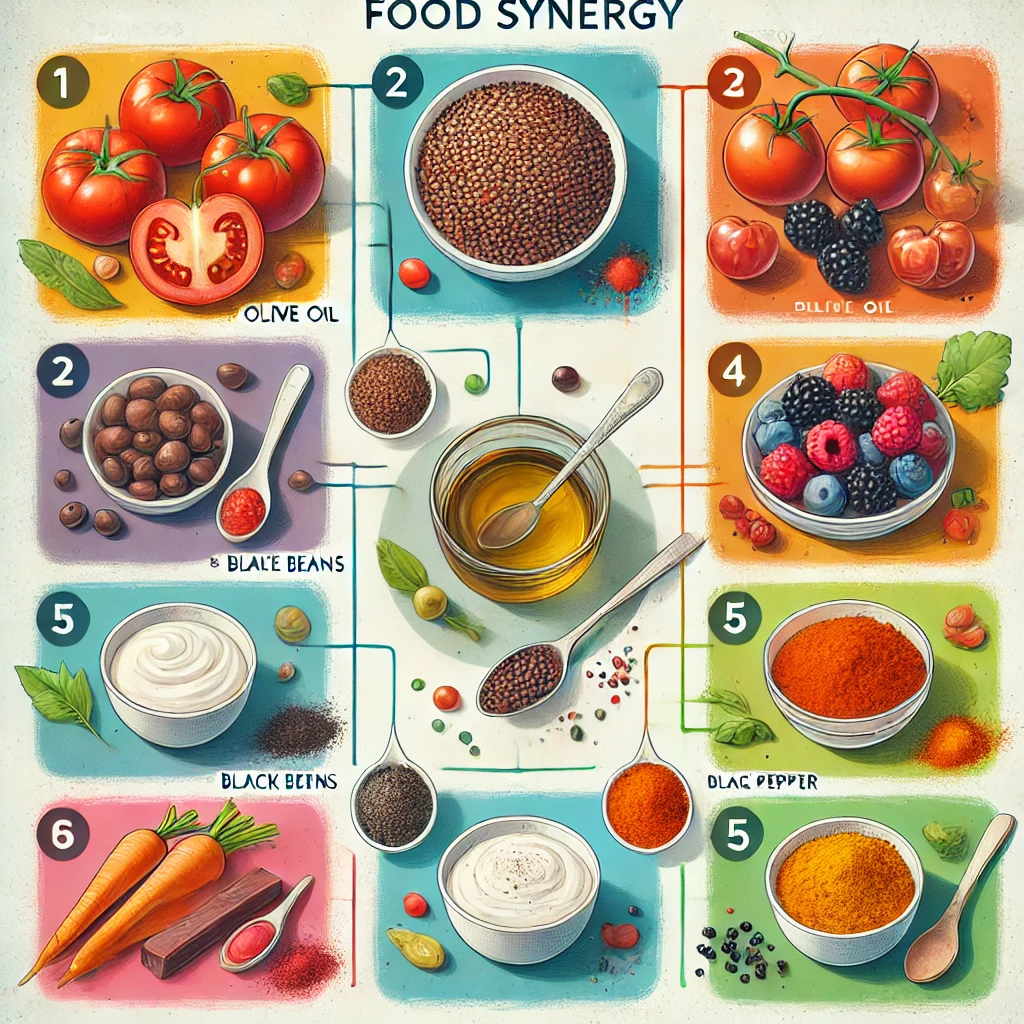
For the past 50 years, I have been passionately devoted to cooking, nutrition, and health and fitness, a journey that has profoundly shaped my life. My enthusiasm for creating delicious, nourishing meals has always been complemented by a deep understanding of how food fuels our bodies and impacts our overall well-being. Through dedication and consistency, I have achieved remarkable results that reflect my commitment to these values. I genuinely enjoy exploring new recipes, experimenting with ingredients, and sharing my love for healthy living with others. My childten, friends, and family can vouch for my cooking skills when it comes to dinner parties of Hors d’oeuvres, appetizers, entrees, and pies. This lifelong passion continues to inspire me, motivating me to learn more and stay active in the kitchen and beyond.
In a world where dietary choices can feel overwhelming, the concept of food synergy offers a refreshing perspective on nutrition. Food synergy refers to the phenomenon where the nutritional benefits of different foods enhance one another when consumed together, resulting in a greater overall impact on health than when the foods are eaten separately. This article will explore how strategically combining whole and organic foods can help individuals meet their daily recommended allowances, address nutrient gaps, and ultimately improve their well-being. Please check out this energetic talk by Essentia Health
Combining foods can indeed create a synergistic effect, where the nutritional benefits of each food enhance the overall impact when consumed together. This phenomenon, often referred to as “food synergy,” can result in a greater variety of nutrients and health benefits than when the foods are consumed separately.
Understanding Nutritional Gaps
Many people struggle to meet their daily nutrient requirements, often falling short of essential vitamins, minerals, and macronutrients. According to the CDC, many adults do not get the recommended amounts of fruits and vegetables in their diets, leading to deficiencies in key nutrients like fiber, potassium, and vitamin D. Food synergy provides a practical solution by allowing individuals to create nutrient-dense meals that can bridge these gaps.
For example, combining dark leafy greens, such as kale or spinach, with a source of healthy fat, like olive oil or avocado, enhances the absorption of fat-soluble vitamins (A, D, E, and K) present in the greens. This not only maximizes the nutritional benefits of the meal but also ensures that your body effectively utilizes the nutrients consumed.
Exploring Food Combinations
To harness the power of food synergy, it’s essential to identify specific combinations that yield maximum health benefits. Here are some examples of synergistic pairings:
1. Tomatoes and Olive Oil: The lycopene in tomatoes, a powerful antioxidant, is better absorbed when paired with healthy fats, such as olive oil. This combination may help reduce the risk of chronic diseases like heart disease and cancer.2. Quinoa and Black Beans: When these two protein sources are combined, they create a complete protein, meaning they provide all nine essential amino acids. This combination is an excellent option for vegetarians and vegans looking to boost their protein intake.
2. Quinoa and Black Beans: When these two protein sources are combined, they create a complete protein, meaning they provide all nine essential amino acids. This combination is an excellent option for vegetarians and vegans looking to boost their protein intake.
3. Carrots and Hummus: The beta-carotene in carrots is a precursor to vitamin A, and consuming them with hummus (which contains healthy fats from tahini) enhances absorption. This combination supports eye health and boosts immune function.
4. Berries and Yogurt: The antioxidants in berries work synergistically with the probiotics in yogurt, promoting gut health while delivering a powerful punch of vitamins and minerals.
5. Turmeric and Black Pepper: Turmeric contains curcumin, a compound known for its anti-inflammatory properties. When combined with black pepper, which contains piperine, the absorption of curcumin increases significantly, enhancing its health benefits.
The Role of Whole and Organic Foods
Incorporating whole and organic foods into your diet is crucial for maximizing the benefits of food synergy. Whole foods, such as fruits, vegetables, whole grains, and lean proteins, are minimally processed and retain their natural nutrients. Organic foods, grown without synthetic fertilizers or pesticides, often boast higher nutrient levels and fewer harmful additives.
Choosing organic options not only supports sustainable farming practices but also reduces exposure to harmful chemicals. By prioritizing whole and organic foods, you can create a foundation for a healthy diet that supports food synergy principles.
Practical Applications: Recipes to Try
To help you implement food synergy in your daily meals, here are a few delicious recipes that highlight synergistic food combinations:
1. Quinoa Salad with Avocado and Spinach
Ingredients: Cooked quinoa, fresh spinach, diced avocado, cherry tomatoes, olive oil, lemon juice, salt, and pepper.
Instructions: Toss all ingredients together and enjoy a nutrient-dense meal packed with healthy fats, fiber, and protein.
2. Sweet Potato and Black Bean Tacos
Ingredients: Roasted sweet potatoes, canned black beans, corn tortillas, avocado, cilantro, and lime juice.
Instructions: Fill tortillas with roasted sweet potatoes and black beans, then top with avocado and cilantro for a delicious and filling meal.
3. Berry Smoothie Bowl
Ingredients: Frozen mixed berries, yogurt, a splash of almond milk, and toppings like granola and chia seeds.
Instructions: Blend berries, yogurt, and almond milk until smooth. Pour into a bowl and top with granola and chia seeds for added crunch and nutrition.
Conclusion
Food synergy is more than just a trendy concept; it’s a practical approach to enhancing nutrition and overall health. By combining whole and organic foods, you can create meals that not only taste great but also maximize the benefits of each ingredient. Whether you’re looking to fill nutrient gaps or improve your overall wellness, understanding and implementing food synergy can empower you to make healthier dietary choices. So, the next time you sit down for a meal, think about the combinations you can create to unlock the full potential of your food.
Discussion on Food Stores and Consumer Education
In many grocery stores, the concept of food synergy is often underutilized or misunderstood. While stores may offer a wide variety of foods that can be combined for enhanced nutritional benefits, they frequently lack educational initiatives to inform consumers about these synergies. For example, while you might find fresh kale, avocados, and olive oil readily available, there is often little signage or information suggesting how these items work together to boost nutrient absorption.
Many consumers may shop for individual items without understanding how to combine them effectively to maximize health benefits. Food stores can play a pivotal role in bridging this gap by providing educational materials, in-store cooking demonstrations, or signage that highlights beneficial food combinations. By doing so, they could empower shoppers to make informed choices that improve their health outcomes. Without this guidance, consumers might miss out on the synergistic advantages that come from thoughtfully pairing whole and organic foods.
Furthermore, the marketing of certain products often focuses on single benefits rather than the potential of combinations. For instance, a health food store might promote turmeric for its anti-inflammatory properties without suggesting that pairing it with black pepper significantly enhances its absorption. Such missed opportunities not only affect individual health but also undermine the broader public understanding of nutritional science, leaving consumers navigating a complex landscape of dietary choices without the tools to make the most effective combinations for their well-being.
References on Food Synergy
1. Books:
“The Food Revolution: How Your Diet Can Help Save Your Life and Our World” by John Robbins – This video and book discusses the benefits of whole, plant-based foods and highlights food combinations that enhance nutrient absorption.
“Nourishing Traditions” by Sally Fallon – This video and gascinating book emphasizes the importance of traditional food pairings and how they can maximize health benefits.
“Food and Nutrition: What Everyone Needs to Know” by John F. B. Hughes– This audio book provides a comprehensive overview of nutrition and includes sections on food synergy.
2. Articles and Studies:
“Food Synergy: The Power of Nutrient Interactions” (National Institutes of Health) – This article explores the concept of food synergy and its implications for health.
“The Benefits of Pairing Foods” (Harvard Health Publishing) – This article discusses various food pairings that enhance nutrient absorption and overall health.
“Food Pairing: The Science of Flavor” (The New York Times) – This article examines how certain food combinations can enhance flavor and health benefits.
3. Websites:
Nutrition.gov – This government resource provides guidelines and information about nutrient intake and the benefits of food combinations.
The Academy of Nutrition and Dietetics – Their website features articles and resources on food synergy and healthy eating.
These resources will provide a solid foundation for understanding food synergy and its implications for nutrition and health.





